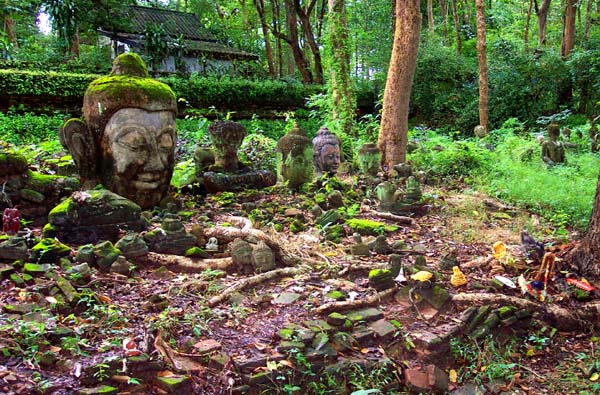Wat Umong, Chiang Mai
Chedi atop the artificial mound.
Wat Umong is unique in many respects. For one, it's built in the foothills of Suthep mountain and is still heavily forested. But the most unique feature of the temple are the tunnels which give the wat its name (umong is the Thai word for "tunnel").
The tunnel leading to the altar of Wat Umong
The monastery was later abandoned and wasn't used again until the 1940's. The long disuse is probably what accounts for the overgrown atmosphere of the temple. That's why the temple is so great to visit right after the rains have gone. The brick walls of the mound are covered with moss and small plants. Other stone works are covered in moss and vines.
Atop one end of the mound is the temple's chedi, reachable by a short stairway to the left of the tunnel entrances. The main "bell" section of the pagoda is mostly covered in thick vines, giving a strong sense of decay even though the structure of the pagoda appears sound. When I was here in early October 2002, it appeared that the chedi had been opened and the relic inside removed. A curious little ad-hoc altar had been set up on the base of the pagoda right in front of the rough opening in the brick work. The altar consisted of many tiny Buddha images as well as other offerings, apparently left by many people. By August 2007, the pagoda had been restored and most of the vines removed.

"Buddha parts" collected from other monasteries.
The path down winds through the monk's cells and other out-buildings, then back around to the front of the mound. Just as the path turns back towards the main tunnel entrance is a curious collection of Buddha heads and other relics from various temples. This odd collection started when one of the temple's supporters rescued some broken images from an abandoned temple in a nearby province and bought them here. Now, apparently, when people run across such relics or have a broken Buddha they want to replace, they bring them here.
If you continue on the path on past the mound and the pagoda, you'll eventually come to a small lake with many fish, birds and other wildlife.
Getting To Wat Umong
Wat Umong is about 2 kilometers off Suthep Road. Unless you rent your own bicycle or motorcycle, you may want to find a tuk-tuk or car to take you there and wait for you. You can combine a trip here with a visit to Wat Suan Dok, which is also on Suthep Road.Further up Suthep road, not far from Wat Umong, is the Galare restaurant, which sits beside a large lake. It's an excellent place for lunch or a sunset dinner.
Videos
Map
ดูแผนที่ขนาดใหญ่ขึ้น
http://thailandforvisitors.com/north/chiangmai/cm-temps.html
No comments:
Post a Comment